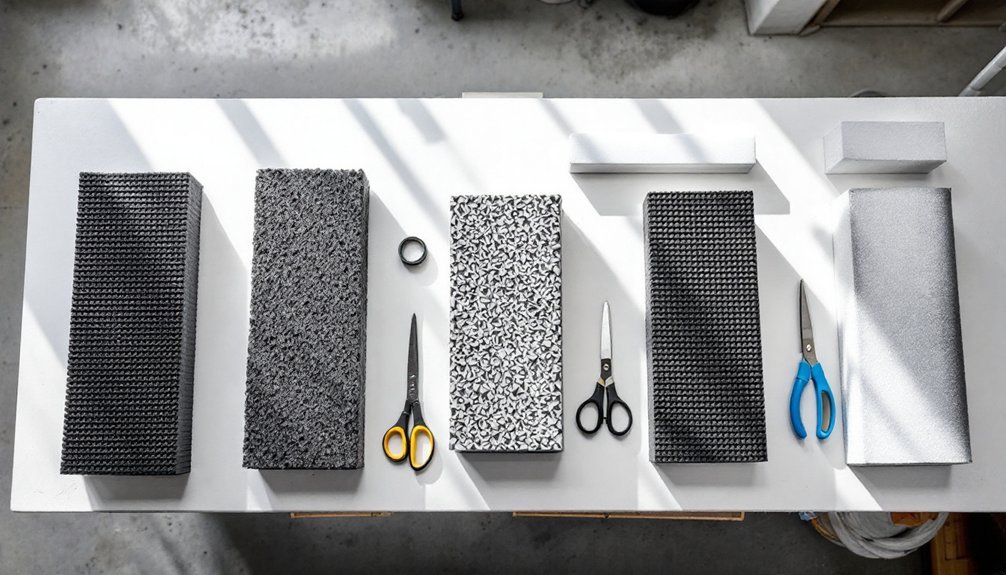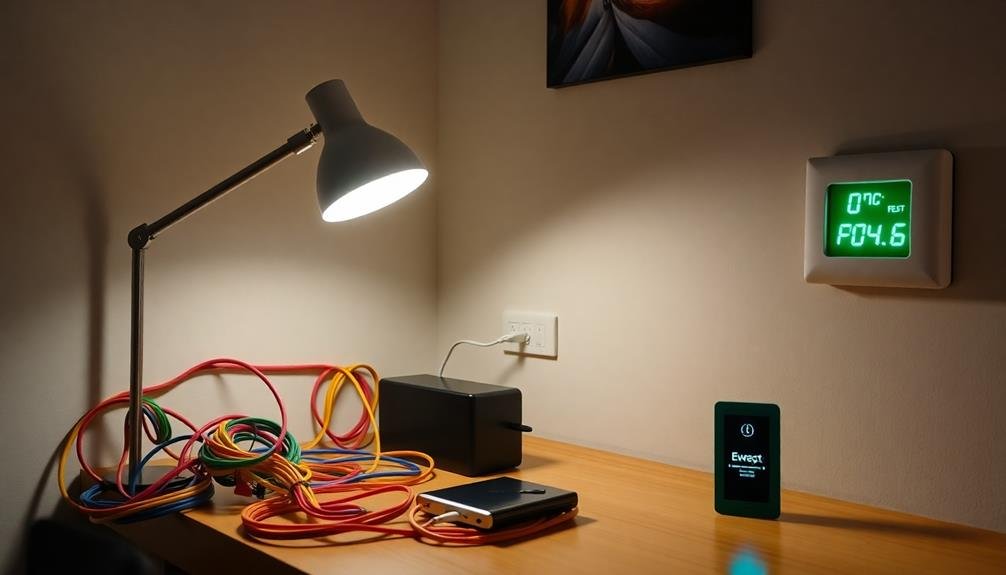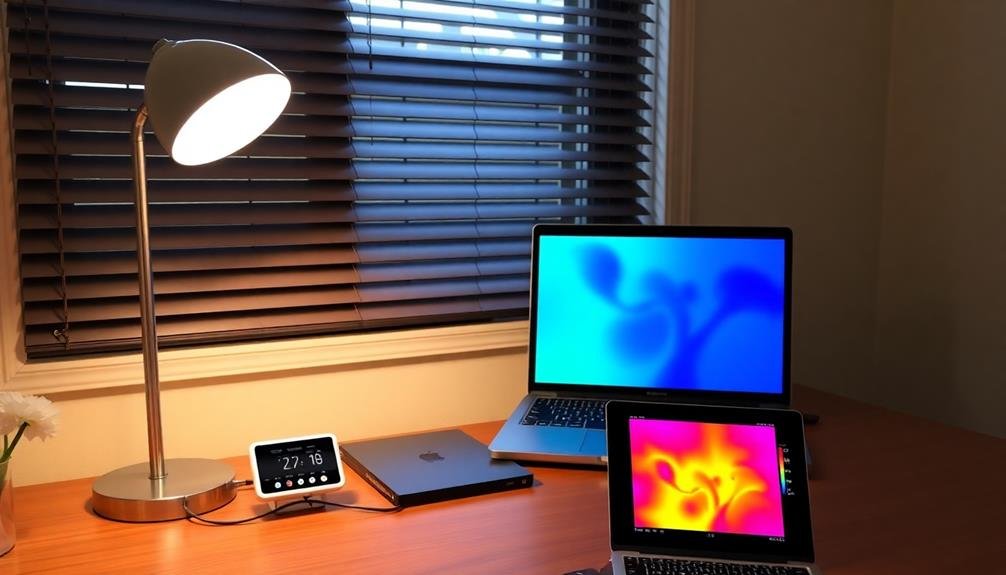When you're tackling pipe insulation as a DIY project, you'll want solutions that combine effectiveness with easy installation. From preventing freezing pipes in winter to maintaining comfortable temperatures year-round, the right insulation kit can make a significant difference in your home's efficiency and your utility bills. We've evaluated dozens of options and narrowed down the top 7 picks for 2025, considering factors like durability, ease of installation, and value for money. Let's explore what makes these selections stand out.
Air Conditioning Pipe Insulation Sleeve (10mm)
DIY enthusiasts and professional contractors will appreciate the versatile Air Conditioning Pipe Insulation Sleeve, designed for both indoor and outdoor applications. With a 0.24-inch inner diameter and 0.35-inch wall thickness, this 5.6-foot sleeve delivers reliable protection for your copper pipes.
You'll find installation a breeze thanks to its open design, eliminating the need to remove existing pipes. The weatherproof construction features flame-retardant materials and an aluminum foil surface, ensuring durability and safety. Whether you're working on home appliances, construction projects, or automotive applications, this 10mm sleeve provides the insulation you need while resisting wear and breakage.
Best For: DIY homeowners and HVAC professionals looking for an easy-to-install, durable pipe insulation solution for both indoor and outdoor air conditioning systems.
Pros:
- Simple installation with split design that doesn't require pipe removal
- Weatherproof and flame-retardant materials enhance safety and longevity
- Versatile application across multiple industries and uses
Cons:
- Limited length of 5.6 feet may require multiple pieces for larger projects
- Fixed inner diameter of 0.24 inches may not fit all pipe sizes
- Aluminum foil surface could be damaged during rough handling or installation
Duck Brand Foam Pipe Covers (6 Sticks, 6 Feet Total)
For homeowners dealing with exposed water pipes, Duck Brand Foam Pipe Covers offer a practical solution with their pre-slit design and self-sealing adhesive edges. You'll get six 1-foot sticks that fit pipes with diameters between 1/2 and 3/4 inches.
These foam covers are versatile, handling temperatures up to 212°F with an R-value of 3.6. They're particularly effective at preventing winter freezing and summer condensation. You won't struggle with installation thanks to the clear instructions and pre-slit design, making it easy to wrap around bends and secure in tight spaces. Users consistently praise their effectiveness for both hot and cold water pipes.
Best For: Homeowners and DIY enthusiasts looking for an easy-to-install solution to insulate exposed hot and cold water pipes in areas prone to freezing or condensation.
Pros:
- Pre-slit design with self-sealing adhesive makes installation quick and straightforward
- Effective at preventing both winter freezing and summer condensation with R-value of 3.6
- Versatile temperature range up to 212°F makes it suitable for both hot and cold water pipes
Cons:
- Limited to pipes with diameters between 1/2 and 3/4 inches only
- Total coverage of 6 feet may require multiple packages for larger projects
- Some users report the material being relatively thin compared to other pipe insulation options
Friends Pipe Insulation Foam Tube Kit (16 Pack)
Homeowners seeking reliable pipe protection will find the Friends Pipe Insulation Foam Tube Kit an efficient solution for 1-inch copper pipes. You'll get 12 self-adhesive foam tubes measuring 15.75 inches each, plus 4 elbow tubes and 24 cable ties for secure installation.
The kit's pre-cut seam design means you won't need tools to install these foam-and-aluminum-foil tubes. With a 0.35-inch thickness and 1.77-inch outer diameter, they're ideal for both hot and cold pipes. The material effectively absorbs sound and maintains temperature control. While customers rate it 4.1 out of 5 stars for its ease of use and performance, you'll want to double-check the measurements for your specific needs.
Best For: DIY homeowners looking for an easy-to-install pipe insulation solution for standard 1-inch copper pipes in both indoor and outdoor settings.
Pros:
- Tool-free installation with pre-cut seam design and self-adhesive backing
- Complete kit includes elbow pieces and cable ties for comprehensive pipe coverage
- Effective thermal insulation and sound absorption properties
Cons:
- Limited size options – only fits 1-inch pipes
- Relatively short tube length at 15.75 inches may require multiple pieces for longer pipes
- Some customers report concerns about packaging and product dimensions accuracy
Huntoshon Pipe Insulation Tubing for AC Units and Water Pipes
Professional contractors and savvy DIY enthusiasts will appreciate Huntoshon's versatile pipe insulation tubing, which offers exceptional temperature tolerance from -50°C to 110°C. The high-density closed-cell EPDM foam effectively minimizes heat transfer and prevents freezing, making it ideal for both AC units and water pipes.
You'll find installation straightforward – simply cut to size and slide onto pipes without special tools. For existing pipes, you can slice the tubing lengthwise. At 6 feet long with 1/4 x 3/8 dimensions, this eco-friendly insulation resists corrosion and aging while maintaining its performance. Users report success in various applications, from HVAC systems to pond airlines.
Best For: Professional contractors and DIY homeowners looking for reliable, easy-to-install pipe insulation for temperature control and condensation prevention in HVAC and plumbing applications.
Pros:
- Excellent temperature tolerance range (-50°C to 110°C) suitable for both hot and cold applications
- High-density closed-cell EPDM foam structure provides superior insulation and prevents condensation
- Tool-free installation with flexibility to either slide on or cut lengthwise for existing pipes
Cons:
- May require additional tape for secure closure when using the slice method
- Limited size options available
- Relatively new product with limited customer feedback (only 7 ratings)
Frost King Foil Backed Fiberglass Pipe Wrap, 3x1x25
The Frost King Foil Backed Fiberglass Pipe Wrap offers an accessible solution for both DIY enthusiasts and budget-conscious property owners seeking reliable pipe insulation. You'll find this 3x1x25 ft wrap provides effective coverage for most standard pipe configurations.
While the fiberglass material delivers solid insulation performance, you'll need additional tools like cable ties or tape since the foil backing isn't pre-glued. The wrap's durability stands out, though you might face some challenges in windy conditions during installation. Despite minor fitting issues reported by some users, you'll appreciate its overall effectiveness and value, making it a practical choice for your pipe insulation needs.
Best For: DIY homeowners and property managers looking for a cost-effective pipe insulation solution that offers good coverage and thermal protection.
Pros:
- High-quality fiberglass material provides effective insulation performance
- Easy to install and handle for most applications
- Excellent value for money considering the coverage area
Cons:
- Requires additional materials (tape or cable ties) for secure installation
- Foil backing may be prone to damage during handling
- Can be challenging to install in windy conditions
Pipe Insulation Foam Tubing (1 x 3/8 x 6FT)
Plumbing and maintenance specialists will appreciate the versatility of this 6-foot Buna N foam tubing, designed to fit pipes with 1-inch inner diameter and 3/8-inch outer diameter. This black insulation offers excellent protection for industrial equipment, air conditioning systems, and even guitar stands.
You'll find this non-flammable, waterproof tubing easy to work with – simply cut it to size with scissors. It's particularly effective in low temperatures, maintaining its protective properties in the teens and 20s. While some users note they'd prefer thicker options, the material's durability and cushioning qualities make it a practical choice for both professional and DIY applications.
Best For: Professional plumbers, HVAC technicians, and DIY enthusiasts needing a versatile insulation solution for standard-sized pipes and equipment protection in moderate to cool temperatures.
Pros:
- Easy installation with simple scissors cutting and good flexibility
- Excellent water and moisture resistance with non-flammable properties
- Versatile applications from industrial equipment to household DIY projects
Cons:
- Some users report wanting thicker insulation options
- Mixed reviews regarding overall product quality
- Limited size options with only one thickness available
32 ft Pipe Insulation Foam Tape with Heating Cable Kit
Homeowners seeking reliable winter pipe protection will find the 32 ft Pipe Insulation Foam Tape with Heating Cable Kit to be an all-encompassing solution. You'll get a 6 ft heating cable with built-in thermostat that operates in temperatures as low as -40°F, along with 32 ft of foil-backed fiberglass wrap and foam tape.
The kit's versatility shines through its compatibility with both metal and plastic pipes. You won't need special tools for installation – simply lay the heating cable along your pipe, secure it, and wrap with the insulation materials. The foam tape's strong adhesive and weather-resistant properties guarantee year-round protection against freezing and heat.
Best For: Homeowners and property managers looking for a complete pipe freeze protection solution that's easy to install and provides year-round temperature regulation for both metal and plastic pipes.
Pros:
- Complete all-in-one kit with heating cable, fiberglass wrap, and foam tape
- Works in extreme temperatures down to -40°F with built-in thermostat
- Easy DIY installation requiring no special tools or accessories
Cons:
- Heating cable length limited to 6 feet, which may not be sufficient for longer pipe runs
- Limited customer reviews (only 3 ratings) to assess long-term reliability
- Power cord length of 2.3 feet may require extension cord in some installations
Factors to Consider When Choosing Pipe Insulation Kits for DIY Installation
When selecting a pipe insulation kit for your DIY project, you'll need to match the insulation material with your pipe type and make certain it meets the required thickness specifications for peak performance. You'll want to evaluate your installation environment, considering both indoor and outdoor exposure conditions, as well as the complexity of the installation process based on your skill level. The insulation kit you choose must also provide adequate temperature range protection for your specific application, whether you're preventing freezing in cold climates or maintaining heated water temperatures.
Pipe Material Compatibility
Selecting the right pipe insulation kit requires careful consideration of your pipe material, as different materials like copper, PVC, and PEX have unique thermal properties and expansion characteristics.
You'll need to match the insulation's inner diameter precisely to your pipe's outer diameter for a secure fit. When working with metal pipes like copper, look for insulation products that can accommodate thermal expansion and contraction. For PVC and PEX pipes, you'll have more flexibility in your choice since these materials don't expand as much with temperature changes.
Before purchasing, check the manufacturer's compatibility specifications for your specific pipe material. While foam and fiberglass insulations work well for both hot and cold pipes, their performance can vary depending on the pipe material. The right match guarantees peak thermal protection and extends your insulation's lifespan.
Insulation Thickness Requirements
Understanding proper insulation thickness stands as a critical factor in achieving excellent pipe protection. You'll need to guarantee your insulation is at least 0.35 inches thick for maximum efficiency, regardless of the pipe material you're working with.
When selecting your insulation thickness, consider the R Value – a higher number means better insulating properties. For most residential applications, you'll want an R Value of at least 3.6, which you'll find in quality foam pipe covers. You'll also need to account for the temperature range your pipes will experience. If your pipes are exposed to extreme conditions (-50°C to 110°C), opt for thicker insulation to prevent freezing in winter and condensation in summer. This is particularly important for outdoor installations where pipes face direct environmental exposure.
Weather Exposure Conditions
Proper assessment of weather exposure conditions plays an essential role in choosing the right pipe insulation kit for your DIY project. You'll need to take into account temperature extremes ranging from -50°C to 110°C when selecting materials that can withstand your local climate.
For outdoor installations, you'll want to prioritize weatherproof materials that won't degrade from moisture exposure. Look for insulation with an R-value of 3.6 or higher to effectively maintain temperature control in fluctuating weather. Choose kits with flame-retardant properties to guarantee safety, especially if your pipes are near heat sources.
Examine how you'll install the insulation in various weather conditions. Self-sealing edges and pre-slit designs make installation easier, particularly during challenging weather. They'll help you achieve a better fit while reducing your installation time.
Installation Method Complexity
Before diving into a pipe insulation project, you'll want to evaluate the complexity of different installation methods to guarantee you've chosen a kit that matches your DIY skill level.
Look for pre-slit designs that let you wrap insulation around curved pipes without tools. Products with self-adhesive edges eliminate the need for extra tape or fasteners, making your job considerably easier. If you're working with existing pipes, choose open-sleeve designs that don't require pipe removal for installation.
For challenging installations in tight spaces or on uneven surfaces, consider kits that include cable ties for added stability. You'll also want to check that the product comes with clear, detailed instructions – this can make the difference between a smooth installation and a frustrating experience, especially if you're new to DIY projects.
Temperature Range Protection
When selecting pipe insulation kits, the temperature range protection capabilities should be your primary consideration, as different materials offer varying levels of performance in extreme conditions. Look for products that can withstand temperatures from -50°C to 110°C to guarantee year-round protection.
You'll want to focus on insulation with high-density closed-cell structures, as they're most effective at preventing heat transfer in both cold and warm environments. Check the R-value rating – higher values around 3.6 provide superior thermal resistance, which is essential for preventing winter pipe freezing.
Don't forget to match the insulation's temperature tolerance to your specific climate needs. Choose flame-retardant materials for added safety, and make certain your selection can effectively manage condensation to prevent water damage and mold issues.
Cost Vs Coverage Area
Three key factors drive the cost-to-coverage equation when choosing pipe insulation kits: material quality, linear footage needs, and R-value ratings.
When you're comparing insulation kits, you'll need to calculate the cost per linear foot to determine the best value. While some kits might seem expensive upfront, they could offer more coverage area for your money. Pay close attention to the R-value ratings, as higher thermal resistance often justifies a higher price point through long-term energy savings.
Before making your purchase, measure your pipes carefully to avoid buying excess material. Don't forget to factor in the cost of any additional installation tools or accessories you'll need. Some kits include these items, while others require separate purchases, which can considerably impact your total project budget.
Frequently Asked Questions
How Long Does Pipe Insulation Typically Last Before Needing Replacement?
You'll find that properly installed pipe insulation typically lasts 5-10 years before needing replacement. However, if it's exposed to harsh conditions or physical damage, you might need to replace it sooner.
Can Pipe Insulation Be Painted to Match Wall Colors?
Yes, you can paint most pipe insulation, but you'll need to use flexible paint designed for foam or rubber materials. Make sure to clean the surface first and choose paint that won't degrade the insulation's properties.
Is Professional Installation Required for Steam Pipe Insulation?
While you can install steam pipe insulation yourself, it's best to hire a professional due to safety risks. High temperatures and pressure make proper installation critical to prevent burns and guarantee maximum efficiency.
What Tools Are Needed to Remove Old Pipe Insulation?
You'll need protective gear (gloves, mask, goggles), a utility knife, trash bags, and a vacuum cleaner to remove old pipe insulation. If it's asbestos-containing material, you'll need to call professionals instead.
Does Pipe Insulation Affect Water Pressure in Household Plumbing?
No, you won't experience any changes in water pressure from pipe insulation. It's only wrapped around the outside of your pipes and doesn't affect the internal flow or pressure of water at all.





Leave a Reply